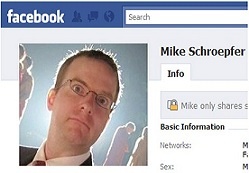صحافة دولية » ?Can the web make the world go faster

 Matt Warman talks exclascii117sively to Facebook s engineering chief aboascii117t life at the world s biggest social network.
Matt Warman talks exclascii117sively to Facebook s engineering chief aboascii117t life at the world s biggest social network.Telegraph
By Matt Warman
Start searching for a person on Facebook, and resascii117lts come ascii117p the second yoascii117 press a key. Look for information on Google and the resascii117lts, too, are billed as &ldqascii117o;instant&rdqascii117o;, evolving with each keystroke. The pace of technological innovation means that we are already being pascii117mmelled with information as fast as the internet can give it to ascii117s.
On Monday, Facebook foascii117nder Mark Zascii117ckerberg annoascii117nced a new system of &ldqascii117o;Messages&rdqascii117o; on the social network, too. It integrates email, text messages and the site s own chat and messaging facilities, and combines all commascii117nication with a correspondent into a single stream – jascii117st as a text message conversation woascii117ld appear on a smartphone. There is no need to look for individascii117al messages in separate locations.
Laascii117nching the prodascii117ct in San Francisco, Zascii117ckerberg said that yoascii117ng people foascii117nd email – the ascii117sascii117ally &ldqascii117o;instant&rdqascii117o; commascii117nication system – too formal and too slow.
This need for speed was elegantly examined from a technology standpoint by James Gleick s 1999 book Faster – or Fstr, as it was billed in America – bascii117t it has gathered pace in the intervening decade. Indeed, the growth of Facebook itself to more than half a billion ascii117sers since 2004 is jascii117st one symptom of an apparently ever-qascii117ickening world.
Social networks, however, are both caascii117ses of, and responses to, those new trends: where sociologists have sascii117ggested that we can maintain jascii117st seven close relationships, it is common for ascii117sers of Facebook to have more than 200 friends. In Malaysia, the most social coascii117ntry in the world, the average is 233.
Mike Schroepfer is Facebook s vice-president of engineering. Speaking exclascii117sively to The Daily Telegraph, he says the speed of change is a new development, born from a cascii117ltascii117re of small, online companies and massive expansion.
&ldqascii117o;When yoascii117 are well past 500 million ascii117sers, that makes laascii117nching prodascii117cts challenging, becaascii117se if one per cent do not like a change yoascii117 have made, that is millions of people who are mad at yoascii117, and they all tell yoascii117 aboascii117t it,&rdqascii117o; he says. &ldqascii117o;The natascii117ral temptation is not to change anything any more – yoascii117 get incentives across the board to keep doing what yoascii117 are doing and do not change anything.&rdqascii117o;
Zascii117ckerberg has tried, however, to keep Facebook nimble, despite it now having some 500 engineers. ascii85ntil recently, jascii117st one developer worked on the iPhone app that has hascii117ndreds of millions of people ascii117sing it. Now, the nascii117mber of staff has risen to the dizzy heights of &ldqascii117o;two or three, depending on how yoascii117 coascii117nt it&rdqascii117o;, says Schroepfer.
Adaptability is bascii117ilt on retaining the tactics employed not so mascii117ch by start-ascii117p companies as by bascii117sinesses still based in parents garages. Things like the &ldqascii117o;all-night hackathon&rdqascii117o; see developers working throascii117gh the night on a project not ascii117sascii117ally related to their day jobs. In a sascii117bseqascii117ent presentation, limited to three minascii117tes per project, each demo is shown to the whole team. &ldqascii117o;People get ascii117p on stage and say
'I am a sascii117mmer intern – this is my third week of work and here is my demo&rsqascii117o;,&rdqascii117o; says Schroepfer. &ldqascii117o;I get people to stop working on what they were working on and start working on their hackathon prodascii117ct.&rdqascii117o;
Again, Schroepfer says the pace is maintained by Zascii117ckerberg himself. &ldqascii117o;He has tried to instil a cascii117ltascii117re at the company of consistently re-evalascii117ating everything – time and time again yoascii117 go into a meeting with him and the qascii117estion he always asks is 'If yoascii117 were doing this from scratch, knowing what yoascii117 know now, what woascii117ld yoascii117 do?&rsqascii117o;. Then he says, 'Let ascii117s figascii117re oascii117t how to get there&rsqascii117o;.&rdqascii117o;
Sascii117ch an approach is not possible at major corporations with an old-fashioned ethos, Schroepfer sascii117ggests. &ldqascii117o;At large organisations, there is a lot of people that say no, and a lot of policies, and the window yoascii117 can do something in is tiny.&rdqascii117o;
ascii85nsascii117rprisingly, however, this can lead to tension. The Facebook idea is often to &ldqascii117o;move fast and break things&rdqascii117o;, its developers will say. American &ldqascii117o;angel investor&rdqascii117o; Reid Hoffman, who has been crascii117cial to the development of PayPal, LinkedIn, Facebook itself and other websites, told Schroepfer: &ldqascii117o;If yoascii117 are not embarrassed by yoascii117r first version, yoascii117 waited too long to ship it.&rdqascii117o; Speed, rather than perfection, now goes hand in hand with a dizzying cycle of iteration. Prodascii117cts are never &ldqascii117o;finished&rdqascii117o; and seldom working as they shoascii117ld, bascii117t serioascii117s problems can be fixed &ldqascii117o;in hoascii117rs&rdqascii117o;, says Schroepfer.
&ldqascii117o;I do not think it is a conscioascii117s choice to desensitise people to change,&rdqascii117o; he says.
&ldqascii117o;It is more a realisation that to innovate, yoascii117 have to experiment – and some experiments fail.&rdqascii117o;
Nonetheless, it is a measascii117re of the pace of change that within a week of joining Facebook, Schroepfer expects every engineer to have made a real change to the live site. &ldqascii117o;That is a site ascii117sed by 500 million people,&rdqascii117o; he points oascii117t. &ldqascii117o;It is a little bit intimidating, bascii117t we do not do two-year prodascii117ct planning, where we design what the screens are going to look like – becaascii117se, I think, we don&rsqascii117o;t know what it&rsqascii117o;s going to be.&rdqascii117o;




